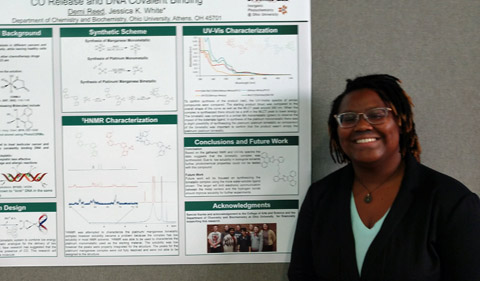Two members from Ohio University’s Chemistry & Biochemistry Department recently presented original research at the 2019 NOBCChE national meeting in St. Louis from Nov 18 – 21.
The annual meeting of the National Organization for the Professional Advancement of Black Chemists and Chemical Engineers (NOBCChE) provides students, postdocs, faculty, and industry members the opportunity to engage with their peers and colleagues. Furthermore, the conference serves as a platform to network, apply for graduate school and jobs, share original research, and attend professional development seminars. Although OHIO does not currently have a NOBCChE student chapter, efforts are currently under way to establish a chapter on campus.
OHIO senior Demi Reed ’20, majoring in Forensics Chemistry and working in Dr. Jessica K. White’s laboratory, presented a poster titled “Synthesis of bimetallic complexes for light-induced CO release and DNA covalent binding.” For more information regarding light-activated release of small molecules with potential therapeutic applications, contact White at whitej7@ohio.edu.
Dr. Travis A. White, Assistant Professor of Chemistry, presented a talk titled “Driving solar hydrogen production with earth-abundant Cu(I) photosensitizers.” For more information regarding photocatalytic water reduction to hydrogen fuel, contact him at whitet2@ohio.edu.
“If you are interested in helping to start OHIO’s NOBCChE student chapter, or have questions about NOBCChE, contact me at whitet2@ohio.edu,” says Travis White.
Abstract for “Synthesis of bimetallic complexes for light-induced CO release and DNA covalent binding”
Abstract: Cisplatin, cis-[Pt(NH3)2Cl2], is a common chemotherapeutic agent that forms covalent adducts with DNA through thermal Pt-Cl bond dissociation. Despite cisplatin’s wide chemotherapeutic use, it is often plagued by cellular resistance which makes it less effective in treating cancers. In the quest to develop better anti-cancer agents, recent research supports the use of carbon monoxide (CO) to sensitize cancer cells to chemotherapy drugs such as cisplatin. The creation of photoactivated CO releasing molecules (photoCORMs) has allowed for controlled delivery of CO to cancer cells using low energy light. The purpose of this research is to covalently couple a Mn(I) photoCORM to a cisplatin analogue in an effort to provide a less invasive and more selective cancer treatment. This was attempted with the synthesis of a bimetallic complex, [Cl2Pt(BL)Mn(CO)3(CH3CN)]+, in which BL is a diimine bidentate bridging ligand. Through irradiation with low energy visible light, the compound releases CO and the cisplatin analogue covalent binds to DNA. The compound was synthesized by adjusting different parameters of the synthetic approach (BL, solvent, reaction time). The product analysis by FTIR, 1H NMR, and UV-Vis spectroscopy, and the photochemical ligand dissociation reactions will be presented.
Abstract for “Driving solar hydrogen production with earth-abundant Cu(I) photosensitizers”
Abstract: Storing solar energy in the form of chemical bonds (often termed “solar fuels”) is an attractive approach to generate renewable energy sources that can be stored for later consumption. At the molecular level, understanding the factors that dictate light absorption, charge separation, catalyst-substrate interaction, and system regeneration provides valuable insight towards the intelligent design of more efficient photocatalytic systems. One project in my lab focuses on the development of Earth-abundant, visible light absorbing Cu(I) photosensitizers to photoinduce electron transfer reactions, ultimately delivering redox equivalents to a catalyst for proton reduction to hydrogen gas. Cu(I) photosensitizers of the design [Cu(PP)(NN)]PF6 (PP = bidentate diphosphine ligand; NN = bidentate diimine ligand) are capable of visible light absorption beyond 500 nm to populate emissive charge transfer excited states with sufficient lifetime to undergo bimolecular electron transfer. Photoexcitation in the presence of an electron donor reductively quenches the Cu(I) photosensitizer excited state, affording a one-electron reduced photosensitizer capable of electron transfer to a proton reduction catalyst and subsequent hydrogen evolution. The identity of the ligands on the Cu(I) photosensitizer strongly impacts the photocatalytic activity by varying the structural, redox, and photophysical properties, the results of which will be presented.





















Comments